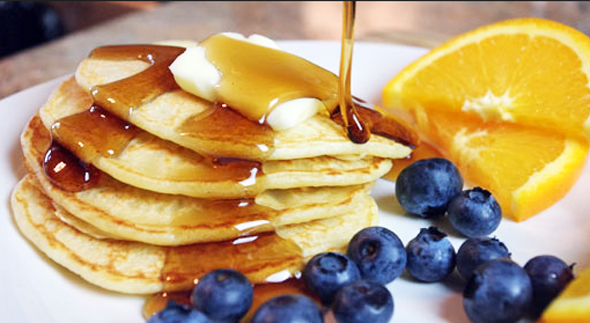Mama’s Punjabi Recipes: Ghar de Pancakes (Homemade Pancakes)
Saved under Community, Current Stories, Recipe Corner
Tags: Baytown, Clear Lake, Cypress, Desi news, Greater Houston, Homemade Pancakes, Houston, Houston Desi news, India, Indian American community, Indian News, Indians in America, Indo-American News, Katy, Mama’s Punjabi Recipes, NRI, pearland, south asia, South India, Sugar Land, Texas, USA
This is not really a Punjabi recipe, but it is one that will appeal to Indian American families and all those who live in the West where pancakes are a favorite treat. In the US, most people just go to the grocery store to buy a packet of ready-to-cook pancake mix. But if they only knew how quick and easy these round cakes are to make with ingredients found at home, they would think twice!
In France, for example, they make crepes, which are a variation of pancakes, using a similar recipe and eat them with different types of fillings, including strawberry preserves or semi-soft chocolate paste. In India, the nearest comparable dishes are pudde, usually salty and made of besan (chickpea flour) or sweet and made of atta (wheat flour).
But as people from the Indian Subcontinent have immigrated to other countries, they have come to appreciate some of the foods of their adopted homelands and have even improvised and created their own versions of foods of their homelands – like chicken tikka masala which was first made in London – or they have made local foods to suit their tastes like Tex-Mex tacos with a desi flavor or tandoori pizza.
So people will be surprised to learn that they probably already have all the ingredients in their kitchen to make ghar de pancakes (homemade pancakes). And, if they want, they can use many different types of fillings – from preserves and plain syrup to sweetened cream cheese or the favorite of many young kids, the sweetened hazelnut cocoa spread, Nutella.
I discovered just how much my homemade pancakes were appreciated when my great-grandkids – 6 year-old Shashi Nila and 2 year-old Shiva – came over two weeks ago for a late breakfast. I quickly pulled together all the ingredients, made the paste and cooked the pancakes over a tava (flatplate). The kids added their favorite sweet filling and, to my delight, gobbled the pancakes up!
Ingredients:
• 3/4 cup maida (wheat flour)
• 1 anda (egg)
• 1 cup lassi (buttermilk)
• 2 tbsp makhan (butter)
• ¼ cup chinni (sugar)
• ½ tsp baking soda
• 3 tsp baking powder
• ½ tsp namak (salt)
Directions:
1. Break the egg in a large bowl, pour in the buttermilk and beat till they are well mixed.
2. Now slowly pour in the maida, mixing continuously and thoroughly so that lumps are not formed by the flour.
3. When the paste is made, add in the rest of the ingredients and mix thoroughly.
4. Put a tava (flatplate) or flat frying pan on the stove over medium heat; coat the surface with a dab of oil and wait till it is nicely hot.
5. With a tablespoon or small ladle, place some of the paste on the frying pan and spread into as large as you want into a ¼ thick flat disk.
6. When small holes appear on the surface of the disk, flip it over with a spatula. Now let the other side cook till it is slightly brown.
7. Remove the cooked pancake and place on a plate to serve.
8. Cook the rest of the batter the same way and serve with your favorite toppings.
MAMA’S TIP OF THE WEEK: CLEAN CALCIUM DEPOSITS IN PANS WITH WHITE VINEGAR
One of the most common things that Indians do is make chai (tea) by boiling water, usually in small pot or saucepan. After repeated uses, a white residue can form on the inside surface of the pot, which is from the calcium and magnesium deposits in the water. This is especially true if you live in a place with hard water.
Rather than scrub the white residue away, try using some common white vinegar. Just pour some – perhaps half an inch or more – into the pan and bring it to a boil. When it is hot, just swirl around the rest of the residue on the sides and let it sit for a while. You’ll be amazed to see the residue disappear. Now just rinse the pan out several times, wash and let it dry.

Shakuntla Malhotra is a skilled cook of Punjabi dishes made in the old-fashioned style that she learnt as a young woman in her ancestral home in Lyallpur (since renamed Faisalabad), India before it became part of Pakistan after the Partition in 1947. People have often admired her cooking for its simplicity and taste that comes with each mouthful. Even in her mid-eighties, she continues to cook daily and agreed to share some of her delectable Punjabi recipes

